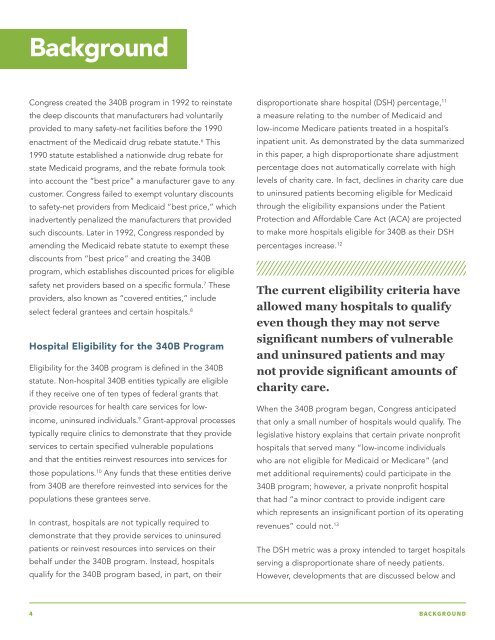BENEFITING HOSPITALS NOT PATIENTS
1rI7CJA
1rI7CJA
Create successful ePaper yourself
Turn your PDF publications into a flip-book with our unique Google optimized e-Paper software.
Background<br />
Congress created the 340B program in 1992 to reinstate<br />
the deep discounts that manufacturers had voluntarily<br />
provided to many safety-net facilities before the 1990<br />
enactment of the Medicaid drug rebate statute. 6 This<br />
1990 statute established a nationwide drug rebate for<br />
state Medicaid programs, and the rebate formula took<br />
into account the “best price” a manufacturer gave to any<br />
customer. Congress failed to exempt voluntary discounts<br />
to safety-net providers from Medicaid “best price,” which<br />
inadvertently penalized the manufacturers that provided<br />
such discounts. Later in 1992, Congress responded by<br />
amending the Medicaid rebate statute to exempt these<br />
discounts from “best price” and creating the 340B<br />
program, which establishes discounted prices for eligible<br />
safety net providers based on a specific formula. 7 These<br />
providers, also known as “covered entities,” include<br />
select federal grantees and certain hospitals. 8<br />
Hospital Eligibility for the 340B Program<br />
Eligibility for the 340B program is defined in the 340B<br />
statute. Non-hospital 340B entities typically are eligible<br />
if they receive one of ten types of federal grants that<br />
provide resources for health care services for lowincome,<br />
uninsured individuals. 9 Grant-approval processes<br />
typically require clinics to demonstrate that they provide<br />
services to certain specified vulnerable populations<br />
and that the entities reinvest resources into services for<br />
those populations. 10 Any funds that these entities derive<br />
from 340B are therefore reinvested into services for the<br />
populations these grantees serve.<br />
In contrast, hospitals are not typically required to<br />
demonstrate that they provide services to uninsured<br />
patients or reinvest resources into services on their<br />
behalf under the 340B program. Instead, hospitals<br />
qualify for the 340B program based, in part, on their<br />
disproportionate share hospital (DSH) percentage, 11<br />
a measure relating to the number of Medicaid and<br />
low-income Medicare patients treated in a hospital’s<br />
inpatient unit. As demonstrated by the data summarized<br />
in this paper, a high disproportionate share adjustment<br />
percentage does not automatically correlate with high<br />
levels of charity care. In fact, declines in charity care due<br />
to uninsured patients becoming eligible for Medicaid<br />
through the eligibility expansions under the Patient<br />
Protection and Affordable Care Act (ACA) are projected<br />
to make more hospitals eligible for 340B as their DSH<br />
percentages increase. 12<br />
The current eligibility criteria have<br />
allowed many hospitals to qualify<br />
even though they may not serve<br />
significant numbers of vulnerable<br />
and uninsured patients and may<br />
not provide significant amounts of<br />
charity care.<br />
When the 340B program began, Congress anticipated<br />
that only a small number of hospitals would qualify. The<br />
legislative history explains that certain private nonprofit<br />
hospitals that served many “low-income individuals<br />
who are not eligible for Medicaid or Medicare” (and<br />
met additional requirements) could participate in the<br />
340B program; however, a private nonprofit hospital<br />
that had “a minor contract to provide indigent care<br />
which represents an insignificant portion of its operating<br />
revenues” could not. 13<br />
The DSH metric was a proxy intended to target hospitals<br />
serving a disproportionate share of needy patients.<br />
However, developments that are discussed below and<br />
4 BACKGROUND


